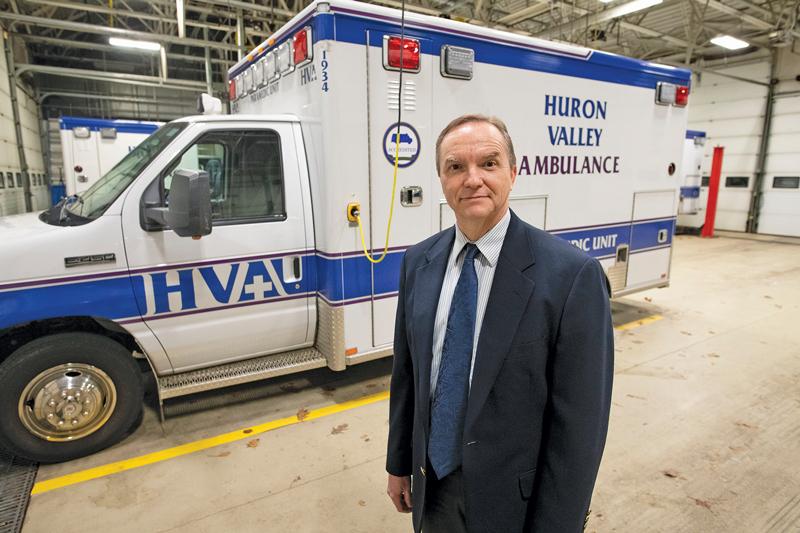HVA needs 185 paramedics and emergency medical technicians to fully staff its Washtenaw County ambulances. In November, it had just 144.
“And it’s not like a restaurant [that] can go, ‘OK, we’re going to adjust our hours,'” says Ron Slagell, president and of CEO of Emergent Health Partners, HVA’s nonprofit parent. To keep its vehicles staffed 24/7, HVA is working its employees harder–and that’s causing more of them to leave.
EMTs earn just $15 to $17 hourly. Skilled paramedics make $18 to $31, but like EMTs, are constantly on the front lines of the pandemic.
“We’ve had about 20 percent of our workforce that has contracted COVID at some point during the past 2 years,” emails Slagell. “Several were hospitalized for a short period. Fortunately, most were not serious cases.”
Still, it’s no wonder that “people [are saying] it’s just not worth it, I’m just going to spend time with my family.”
“At the start of the pandemic, we were actually very stable,” HVA paramedic Eric Farris says. “Everyone was very happy to have a steady job, and there weren’t many people trying to transition [to other] careers.”
Now, Farris says, “We’re starting to revert back to normal, which unfortunately is more turnover.” The result is a “steadily worsening” nationwide shortage of paramedics.
HVA former CEO Dale Berry recalls that when he retired three years ago, HVA might typically “have fifteen, twenty vacancies.” They’re now working with twice that number–and that shrunken workforce is handling more calls. HVA transported 14,890 patients in 2020–down slightly from pre-pandemic 2018, but up 25 percent from 2015.
More work for fewer workers inevitably impacted response time, which rose from 8.3 minutes in 2018 to 9.1 minutes so far in 2021 for life-threatening emergency calls.
Slagell emails that recent research “shows that rushing the ambulance to the patient doesn’t impact or improve the ‘patient’s outcome.
“The’ ‘response-time criteria were developed in the eighties, and it was primarily focused on cardiac arrest,” he explains by phone. But “cardiac arrest is like two percent of our calls or less. So we built an entire system around this very small fraction of calls.”
That doesn’t mean folks who call for an ambulance don’t want one there as soon as possible. There’s also concern that if the staffing crisis continues, providers may not be able to maintain the highest level of service.
Ever since St. Joe’s bought a bankrupt private ambulance company in 1981, HVA’s history has been one of increasing capability. Thanks to better-trained staff and better-equipped vehicles, its crews provide advanced life support even before patients reach the emergency room. Now critics inside and outside the business worry that if ambulance services can’t retain staff, they could be reduced to the “pick them up and drop them off” model of forty years ago.
“I don’t necessarily see that happening,” says Farris. “I wouldn’t say we’re to the point of failure yet. But if we continue to go the way we’re headed, if we continue to have these kinds of compounding difficulties and obstacles, we could get there.
“What will probably happen, and it is already happening to a certain extent in a lot of places, is EMS and other public service agencies’ resources are just going to become more scarce.”
“The ultimate answer for HVA, and probably for every ambulance service, is we have to pay better,” says former CEO Berry. “We have to reduce the work weeks.”
“The solution is we have to get more people,” Slagell agrees. “We’ve been working on more flexible and ‘alternate-type schedules, too. And that’s actually had some success.
“We normally do two orientations a month [for potential employees], and we’d see maybe fifteen people a month. In the last two months, we’ve had ‘forty-five to fifty per month.”
But if they can’t increase pay, those new hires, too, are likely to move on. And ambulance services can’t just pass on higher costs.
“We have to get more Medicaid dollars, because everything revolves around Medicaid,” Slagell explains. That’s because more than half the patients HVA carries are covered by the government insurance program for low-income people. Until recently, Medicaid paid just $126 for a transport with basic life support and $230 for advanced life support, plus $3.92 per mile–which he says is only “a fraction of the cost of providing the service.”
Is HVA’s nonprofit model no longer viable? “It’s very, very viable and it’s the best model,” says Berry, the man who helped invent and refine the model. “It’s still viable,” Slagell agrees. But “portions of it … need to be updated.”
Fortunately, that is finally happening: on November 1, Michigan implemented interim Medicaid rates that increased the average payment by $127 per trip. In December, Slagell was meeting with the state about new permanent rates.
